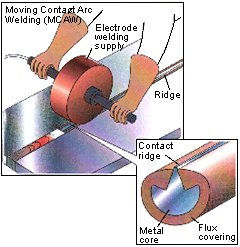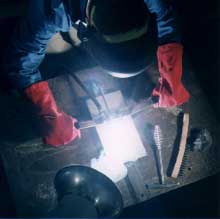Moving contact arc welding
by Wayne Thomas
Description and explanation
In moving contact arc welding (MCAW), current is supplied to a shaped
metal consumable electrode through a sliding or rolling contact tool. The
lying consumable (known as a RidgebackTM
consumable) is flux-covered and features an exposed metal ridge that
protrudes above the flux. Electrical contact between the tool and the
consumable is applied at a relatively short distance from the arc,
eliminating the resistive heating path of the electrode.
The MCAW technique is under development and offers an easy-to-use
alternative cladding, welding and repair method. The process is suitable for
either manual or mechanised operation. It can be applied with restricted
access and is amenable to remote operation.
Fig 1. Basic principle of MCAW using RidgebackTM
consumable

Present status of MCAW
The process is novel in that it differs from the traditional Firecracker
(Elin-Hafergut) and other lying consumable welding techniques because the
contact point is kept as close as possible to the burning arc. This
minimises resistive heating between the contact point and the arc, enabling
the RidgebackTM consumable to carry
greater currents, or, almost infinite lengths to be used in one operation.
Restricted access and remote operation capability are two of the major
advantages unique to the MCAW process.
Although the feasibility has been demonstrated, the MCAW process has not
yet been used commercially. Underwater welding under dry conditions in a
local habitat is a possible application. The practicability of restricted
access conditions has been demonstrated using a local habitat chamber. In
addition, repair welding in hazardous surroundings (e.g. in the nuclear
industry) and welding or repair inside steel tubes and pipes are likely to
provide ideal application for the process.
Important issues
Ease of manufacture of profiled consumables by hot rolling or extrusion,
etc and application of the flux covering on consumables in a more
cost-effective way are important development issues in successful
commercialisation of the process. A further research requirement will be to
develop the process to become positional, i.e. for vertical and overhead
applications.
A potential variant of the MCAW technique is sub-arc in which a plain bar
stock or powder filled consumable is used. The sub-arc variant would not
need a specially shaped rod, and the consumables need not be flux covered.
The technique would make use of a hopper feed, granulated flux and insulated
flux saddles. The sub-arc variant would eliminate the need for any
consumable feed system.
Fig 2. Assessing the feasibiltiy of moving contact arc welding (MCAW)

Benefits
Potentially, the MCAW process has many beneficial features compared with
existing processes which utilise consumables.
The process gives greater productivity as the number of start/stops is
reduced, and longer and/or larger consumables can be used in one welding
operation. Stop/starts can be sites for welding defects such as cold laps;
reduction in stop/starts reduces this associated risk. The use of larger
consumables can reduce/eliminate the need for multi-pass welding of thick
plate.
MCAW uses low-cost, portable equipment and is readily automated. It is
simple to operate and is essentially a low-skill welding/cladding technique
with less associated operator fatigue. It is ideal for applying hardfacing
and corrosion overlays and can be designed to operate in restricted access.
Risks
Typically, the risks associated with traditional arc welding equipment
will also apply to MCAW.
Future prospects
It is expected that MCAW will be used for niche applications were
existing techniques are unable to operate.
|